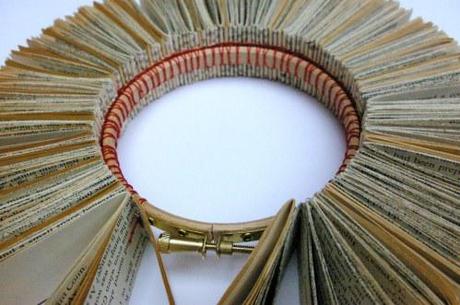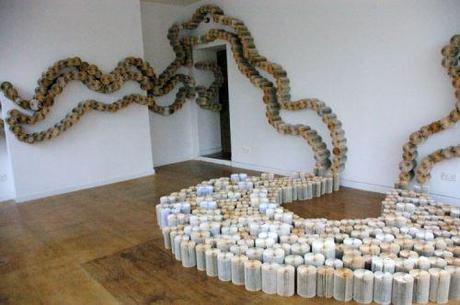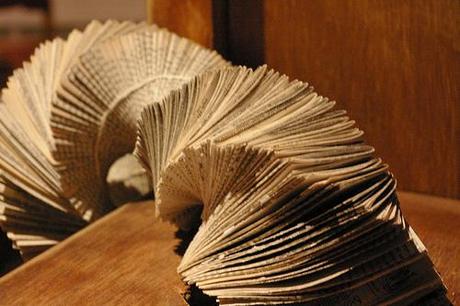
Yvette Hawkins’ work draws upon the experience of the audience, exploring how language, codes and the written word is perceived, broken down and deciphered by the viewer. Yvette is interested in the notion of memories, the cultural psychologies of looking and the differences between socially conditioned learning patterns and biological ones.
Within her practice Yvette explores the book as the object and works on a large scale using multiples to create environments which transform spaces that explore suggestion and secrecy. Yvette is drawn to working with paper as a sculptural medium and using traditional craft techniques, such as folding, cutting, printing, stitching and weaving to explore the environments of both art and craft.
“I really appreciate the familiarity of paper – a material that anyone can relate to. The way I work is very simple, just cutting or folding or sometimes stitching or drawing too. Folds that are the most simple and uncomplicated – mostly because they are the best to build installations with, but also because anyone can do them. I think that works need to be relatable to an audience and I really do think it’s important to engage with your audience in a way that isn’t patronising or complicated. I have found it sometimes difficult to make work for outside because of its fragility, but mostly I find there are so many things to do to paper that I would spend my whole lifetime working with it, without getting bored or tired at all” says Yvette.
Yvette follows a socially-engaged practice which involves members of the public, to physically interact with the artwork, at various stages of the making and presenting of her work.

We hope you enjoy a little insight into what makes Yvette Hawkins tick and her creativity …
Describe your studio/work space. Is it a laboratory/shed/tidy/chaos/treasure trove/secretive cave or something else? My studio is in an old church that has been converted into artist studios, and is the most inspirational place to create. My space is in the main hall and is part open plan, and part secretive! It’s full of books, tools, and bits of machinery that I’ve picked up. It’s incredibly light and full of (papery) life. I have a mini showroom where all my sculptures live, and soon it’ll include a magical shop where people can come and have a nice cup of tea.
What do you love most about paper? I love both its fragility and dexterity. It can be torn, crumpled or damaged so easily, yet through simple manipulation by folding or cutting or layering and bonding it can become very versatile, strong, architectural and repetitive.
With unlimited budget or geographic reach what is your ultimate art material? I’d like to own the largest role of paper in the world and spend 10 years folding it. Then I’d make a house and live in it.

How did you work with paper as a child? Do you remember what you first created with paper? I was always drawing as a child but the first time I had a real appreciation for paper was when I got my first £5 note. I used to get £1 a week in the form of a coin. Then my brother was offered the choice of having a £5 note instead of five coins and I was so jealous. I loved the feel of the note.
What is your relationship to paper? How different is working on paper to any other medium. What freedoms does it allow and what limitations? I really appreciate the familiarity of paper – a material that anyone can relate to. The way I work is very simple, just cutting or folding, or sometimes stitching or drawing. Folds that are the most simplest and uncomplicated – mostly because they are the best to build installations with, but also because anyone can do them and I think that is relatable to an audience.
I find there are so many things to do to paper that I could spend my whole lifetime working with it, without getting bored at all.
What artists do you admire and why? Oh lots. At the moment I love kinetic artists like Conrad Shawcross and Arthur Ganson, who have made the most amazing machines and engineering processes. I feel as though my work relates to them because of the process of manipulating paper in ways that make them move or drift or sing or unfold.
When is a work of art finished? Who knows! I always feel both finished and unfinished in my work. In fact I quite like unfinished works that suggest they have a journey to follow beyond its presentation. Like folding a piece of paper and then unfolding it to see where it has been and where it could go next.
What art do you collect/surround yourself with? I absolutely love good drawings and prints I’ve been buying them mostly from Etsy, but I’m always on the look out for more. I have made a wallpaper installation in my living room from bringing mismatched samples of paper together and putting empty frames in them. It too looks unfinished. Next I’m planning on taking photographs of a forest – all black and white and layering them on a wall to make an enchanted forest. My boyfriend is a ceramicist so we’re currently curating a ceramics gallery.
What are you reading/listening to? I’m reading The Borrower – well I’m about to start. It’s about books, I just can’t get away from them. I’m currently listening to a vacuum cleaner – the church is currently getting cleaned to make way for some new artists to move in.
Describe what you are making right now? I’m currently making a series of books for a project called Book Apothecary, which is a travelling museum of artist books. The theme for the first exhibition is “category”, so I’m thinking about sorting and sifting and collecting and how i might present them in a way that will encourage people to think differently about libraries, books and shelving.
I’m also making lots of origami tessellations which is immense fun, if not very tricky.
What makes you feel most creative and most free? Being inspired by other artists and artworks. Sitting on a bench eating ice-cream and looking at the sea. Travelling on a train and watching the world pass by. Going to the woods and having a photographic adventure.
Visit Yvette Hawkins online at http://www.yvettehawkins.com/

